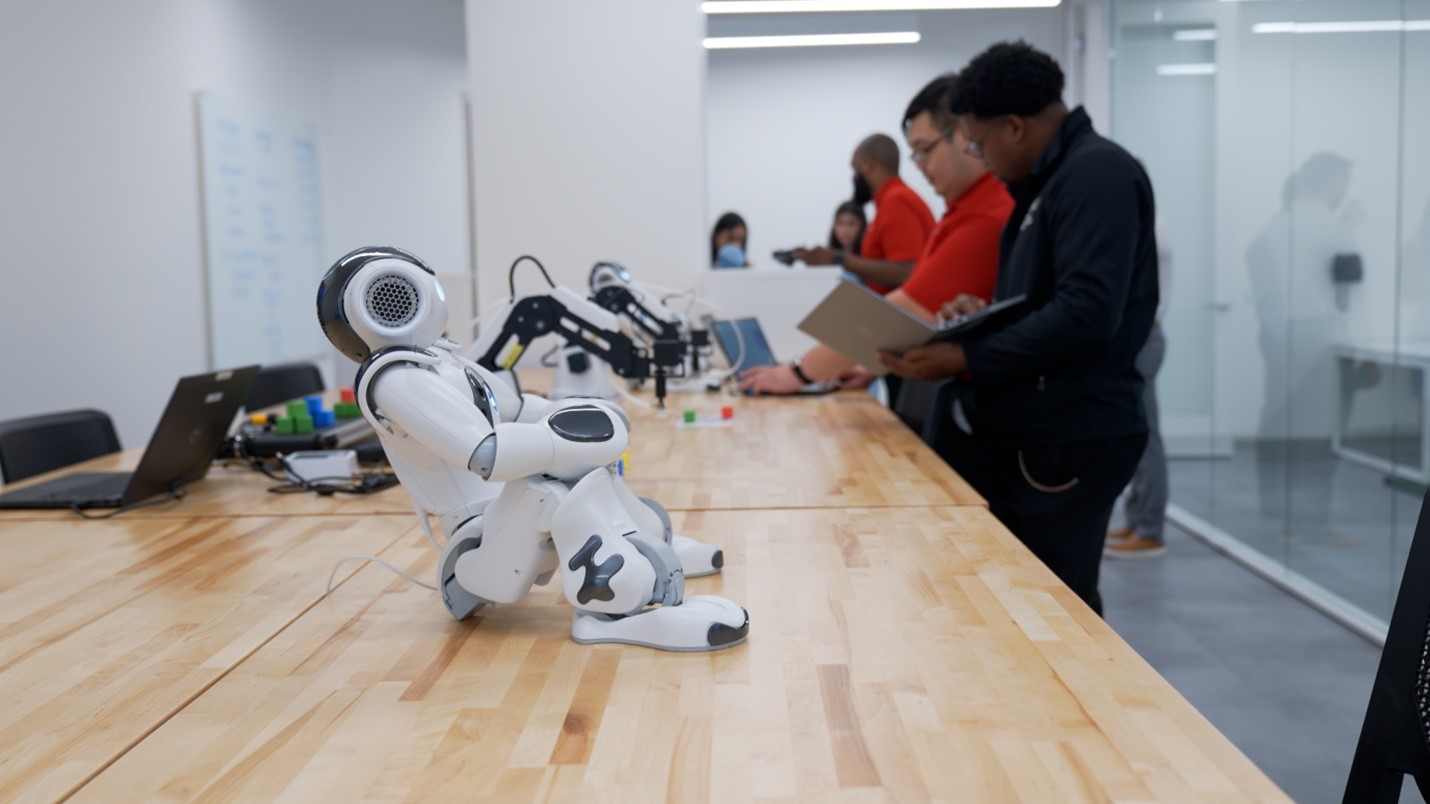RobotLAB Blog
Everything You Need To Know About Robotics in Businesses
How Crucial Is Artificial Intelligence to the Rise of Ed Tech?
By Ellie Poverly-jpg.jpeg?width=1920&name=possessed-photography-jIBMSMs4_kA-unsplash%20(002)-jpg.jpeg) Image Source: www.unsplash.com
Image Source: www.unsplash.com
Anyone in the education sector knows that new technologies are poised to revolutionize the traditional classroom.
In the past few years, educational institutions have adapted to a new normal brought about by the COVID-19 pandemic. Parents, students, teachers and administrators had to remain flexible, adjust to virtual learning environments and adopt new digital technologies to facilitate learning.
Although the industry is still reeling from the adverse effects of the pandemic, the global disruption sparked major growth in one relevant sector: education technology (ed tech).
A primary example of ed tech is artificial intelligence (AI), which has already proven itself as a highly useful, effective tool with various applications and benefits. How important is AI in supporting the rise of the ed tech market? Will more K-12 and secondary education institutions adopt AI-based solutions in the future?
- 0 Comments
- Sep 17, 2022 10:00:00 AM
- Posted by Mike Nardine
- Topics: EdTech, STEM, Education, Computer Science, 21st Century Classroom, School, Student Engagement, Middle School, High School, AI
The Alan B. Levan | NSU Broward Center of Innovation integrates a robotics AI LAB for entrepreneurs

The implementation of the lab will provide entrepreneurs with real world experience in robotics and artificial intelligence.
September 1st, 2022 – San Francisco, CA – The Alan B. Levan | NSU Broward Center of Innovation (“Levan Center”), in partnership with RobotLAB, the leading educational robotics company, partnered to build an artificial intelligence and robotics lab.
- 0 Comments
- Sep 1, 2022 11:11:55 AM
- Posted by Mike Nardine
- Topics: EdTech, STEM, Education, Computer Science, 21st Century Classroom, School, Student Engagement, Middle School, High School, AI
Westworld The Series And Two Important Issues
 I first watched Westworld in 1973. It was a science fiction movie written by Michael Crichton and starting Yul Brynner. Yul Brynner’s character was an out-of-control android which killed visitors to a western-themed amusement park. I remember thinking before watching the movie that Yul Brynner was an odd choice of a malefactor: The last time I’d seen him was as the King of Siam in Oscar Hammerstein II’s musical The King and I; I could not imagine any actor-- no matter how talented--able to make that switch. As it turned out, he was marvelously menacing, and no one in the HBO series Westworld--not even Anthony Hopkins--was his equal.
I first watched Westworld in 1973. It was a science fiction movie written by Michael Crichton and starting Yul Brynner. Yul Brynner’s character was an out-of-control android which killed visitors to a western-themed amusement park. I remember thinking before watching the movie that Yul Brynner was an odd choice of a malefactor: The last time I’d seen him was as the King of Siam in Oscar Hammerstein II’s musical The King and I; I could not imagine any actor-- no matter how talented--able to make that switch. As it turned out, he was marvelously menacing, and no one in the HBO series Westworld--not even Anthony Hopkins--was his equal.
- 0 Comments
- Jan 19, 2017 6:09:08 PM
- Posted by Mike Nardine
- Topics: Robotics
PISA Scores Indicates The Importance of Common Core
Are you by any chance familiar with the P I S A test? Perhaps like me you are acquainted with the test’s dismal results where American students are concerned, but the actual name of the test has remained a mystery--until now.
- 0 Comments
- Dec 8, 2016 7:06:00 PM
- Posted by Mike Nardine
- Topics: Common Core Assistance
THE EVOLUTION OF DARWIN-OP FROM THREATENING TO CUTE
I stumbled over this photo and text on the ROBOTIS support site while looking for something interesting on DARWIN-OP:
- 0 Comments
- Dec 4, 2016 12:14:34 PM
- Posted by Mike Nardine
- Topics: Robotis Op2
Making The Periodic Table of Elements Interesting
According to my friends, almost all of whom are younger than I, there were only four elements in the periodic table when I was a boy: earth, water, air and fire. But all evidence to the contrary, I really wasn’t a contemporary of the great Greek philosopher Empedocles.
- 0 Comments
- Nov 22, 2016 7:58:48 PM
- Posted by Mike Nardine
- Topics: EdTech
Lava NAO and Sky NAO Find a Home At Wellesley Free Library
Here is a riddle: What connects the two newest employees of the Wellesley Free Library and the super-popular Internet game MineCraft? The answer: a ten-year-old boy named Oliver.
- 0 Comments
- Oct 23, 2016 9:44:51 PM
- Posted by Mike Nardine
- Topics: NAO
IBM Watson Helps Teachers Teach Common Core Math
The new common core math standards appear to be the answer to increasing math literacy amongst students. But at the moment the standards are under attack as the popular Internet meme below indicates:
- 0 Comments
- Oct 11, 2016 1:27:41 PM
- Posted by Mike Nardine
- Topics: Common Core Assistance
We choose to go to the moon challenge met by the Silent Generation

In a recent Apple news article , well known tech consultant Tim Bajarin, President of Creative Strategies, Inc., discussed the importance of President John F Kennedy's “we choose to go to the moon speech.” Mr Bajarin believes that that speech given by the president on September 12, 1962 at Rice Stadium in Houston was crucial in the development of a whole generation of engineers and mathematicians: the very people necessary to this nation's winning the last century's great space race to the moon. It is Mr Bajarin’s opinion that “by the mid-1980s, without a similar push by either the US.government or the schools to emphasize science, technology, engineering and math (STEM for short), we lost almost two decades of youth who chose to go into other fields of learning.”
- 0 Comments
- Oct 7, 2016 11:12:47 AM
- Posted by Mike Nardine
- Topics: STEM
Double Robot: Teaching Kids in a Remote Classroom Experience
I have been writing posts for RobotLab the better part of five years. Few things have excited me as much as the Double Robot virtual presence device. And absolutely nothing (not even the money) has done as much to make me feel like one of the RobotLab staff (I live over 1950 miles from the office!).
- 0 Comments
- Sep 23, 2016 3:33:58 PM
- Posted by Mike Nardine
- Topics: double robot
Relevant Posts
- Augmented Reality: A Tool for Teaching Students Robot Programming
- Fostering Innovation Through Youth Education in STEM and EdTech
- How Parents Can Foster STEM Learning Beyond the Classroom
- How Robotics Cultivates a Deep Understanding of Mathematics in Students
- RobotLAB Receives EDTech Chronicle 2023 ‘BESTIE’ Award for Landmark Partnership with American Samoa Dept. of Education.
Subscribe to Email Updates
-
I Want To Learn MoreADDITIONAL INFORMATION
